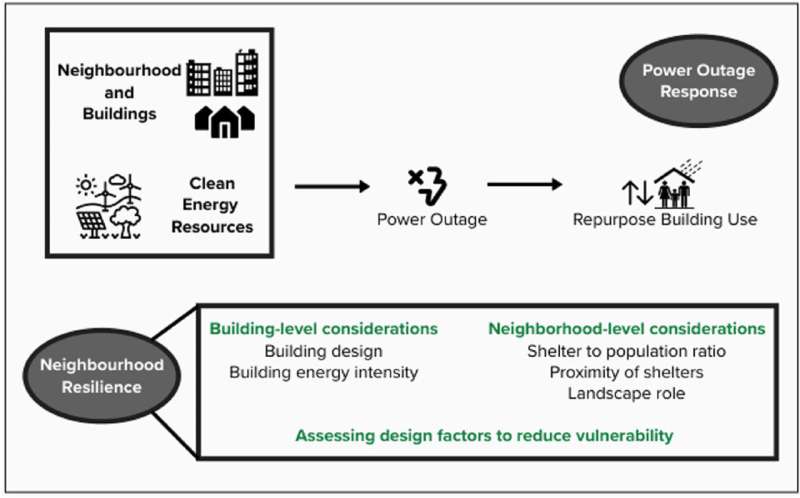This article has been reviewed according to Science X's editorial process and policies. Editors have highlighted the following attributes while ensuring the content's credibility:
fact-checked
trusted source
proofread
Disaster-proofing sustainable neighborhoods requires thorough long-term planning, study shows

Individual neighborhoods will be intimately involved in providing local solutions to collective problems. One measure will be distributed renewable energy production—energy produced at local levels, either by solar technology, wind or other methods, will push cities to achieve their net-zero targets.
However, even these power-generating neighborhoods will remain vulnerable to power outages resulting from natural disasters such as hurricanes, fires or floods. And all of these are likely to become increasingly common due to the effects of climate change. So how will sustainable neighborhoods cope with the pressures put on their energy systems?
Caroline Hachem-Vermette is an associate professor in the Department of Building, Civil and Environmental Engineering at the Gina Cody School of Engineering and Computer Science. In a new paper, she looks at how thoughtful design can reduce a neighborhood's energy vulnerability during power disruptions, as well as which design characteristics are needed if and when local populations need to move to shelters.
The article was published in the journal Renewable and Sustainable Energy Reviews.
In it Hachem-Vermette and co-author Kuljeet Singh from the University of Prince Edward Island analyze the design and energy characteristics of particular kinds of buildings and neighborhoods to assess their vulnerabilities and their access to alternative and renewable energy sources. The authors use several scenarios involving different lengths of power disruption to see which kind of response is most beneficial to the populations affected.
"We focused on the neighborhood unit level because we can look at characteristics and detail levels that are harder to find at the city level," Hachem-Vermette explains.
"Designed to be self-contained in terms of basic conveniences and services, the neighborhood unit is a fundamental concept in urban planning. Neighborhood units serve as a basis for city-level development and design and can be used to understand various sustainable and resilient strategies."
Net-zero but still vulnerable
Designed along sustainable practices, the theoretical neighborhoods were based on the kinds found in typical Canadian municipalities: low-density residential, mixed residential/commercial and retail, high-density residential and mixed high-density residential and industrial. The researchers also assessed the types of energy systems these neighborhoods primarily relied on to provide electrical and thermal energy.
These indicators were considered across scenarios in which power disruptions lasted between one day and over three weeks. They provided reliable estimates regarding energy interruption vulnerability as well as the best measures to be considered to mitigate the effects of these disasters on local populations.
The researchers came away from their study with several recommendations that could improve a stricken neighborhood's resilience.
They urged municipal authorities to do the following: equip large buildings such as schools with the means to be self-sufficient in energy production so they could be used as temporary shelters; modify design standards for shelters to increase their maximum population while still providing good indoor air quality, hygienic spaces for living, food preparation and recreation; and incorporate neighborhood spatial design methods to ensure access to roads, potential shelter buildings and hospitals, and landscapes for energy system installations.
Hachem-Vermette realizes much more study is needed as cities move toward fully sustainable practices in the face of increasingly extreme weather. But she is confident that initiatives such as Concordia's PLAN/NET ZERØ and the Canada First Research Excellence Fund grant announced earlier this year will help her and her fellow researchers find pathways to navigate the societal transition to renewable energy sources.
"My research is at the heart of the effort to build neighborhoods that are decarbonized," she says. "With my background in architecture, urban planning and building engineering, I can pull these disciplines together. Bridging the gaps at the interface of these disciplines is where we will find sustainable and resilient solutions."
More information: Caroline Hachem-Vermette et al, Role of neighbourhood spatial and energy design in reducing energy vulnerability during power disruption, Renewable and Sustainable Energy Reviews (2023). DOI: 10.1016/j.rser.2023.113519

















